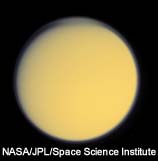—— Could you explain the Cassini-Huygens Mission?
 |
| Titan is the only satellite in the solar system that has a dense atmosphere. The atmosphere is composed mainly of nitrogen and methane. Scientists call this a reducing atmosphere, which means it is dominated by hydrogen compounds, rather than oxygen compounds. Today we could transform the Earth's atmosphere from oxidizing to reducing by adding large quantities of pollutants. A reducing state is typical of ancient atmospheres. |
The Cassini-Huygens mission is one of the last missions of huge size and cost approved in our times. It's a major effort involving NASA, the European Space Agency and also the Italian Space Agency. The main goal of the mission is the exploration of the Saturn system. Why a system? Because Saturn resembles a solar system, in a kind of miniaturized form. What is really important for us at ESA is the role of the Huygens probe. This probe has entered the atmosphere of Titan to measure the chemical and physical characteristics of the atmosphere, and eventually also to explore the surface of the satellite. Titan reminds us of our planet Earth, two or three billion years ago. In other words, for us, exploring Titan is like going back in time on our planet and understanding its beginnings.
—— How did it happen that Huygens continued to function even after landing on Titan?
The Huygens probe was originally designed to be just an atmospheric experiment – it had to function primarily during the descent through Titan's atmosphere. But we also prepared an experiment in case the probe was going to survive for a few seconds or a few minutes on the surface of Titan. At the time of the launch, we thought that most of Titan's surface was covered with oceans or lakes made of liquid methane. So we thought it was absolutely useless to design a lander, because it would sink into the liquid methane in a matter of minutes. It was indeed a great surprise when we realized that the probe actually landed on something that was not liquid, but also not too solid. When the data arrived back to Earth, the mission's project scientist described the surface of Titan as a kind of crème brulée, or flan if you prefer, because it had a very thin crust, rather solid, which broke, and then the probe came to rest on something softer. So that really reminds us of crème brulée. That allowed the probe not to sink, and actually it survived for more than two hours, continuing to transmit scientific data. This was a great surprise to all of us, and a great pleasure from a scientific point of view, because we have collected unexpected data.
|



